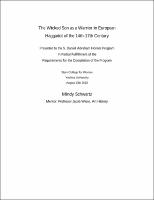Please use this identifier to cite or link to this item:
https://hdl.handle.net/20.500.12202/4508Full metadata record
| DC Field | Value | Language |
|---|---|---|
| dc.contributor.advisor | Wisse, Jacob | en_US |
| dc.contributor.author | Schwartz, Mindy | - |
| dc.date.accessioned | 2019-07-10T17:24:48Z | - |
| dc.date.available | 2019-07-10T17:24:48Z | - |
| dc.date.issued | 2018-08-13 | - |
| dc.identifier.citation | Schwartz, Mindy. The Wicked Son as a Warrior in European Haggadot of the 14th-17th Century Presented to the S. Daniel Abraham Honors Program In Partial Fulfillment of the Requirements for the Completion of the Program Stern College for Women Yeshiva University August 13th 2018. | en_US |
| dc.identifier.uri | https://hdl.handle.net/20.500.12202/4508 | - |
| dc.identifier.uri | https://ezproxy.yu.edu/login?url=https://repository.yu.edu/handle/20.500.12202/4508 | |
| dc.description | The file is restricted for YU community access only. | en_US |
| dc.description.abstract | Because we lack the knowledge of these cultural cues, we will not be able to arrive at a definitive interpretation of this iconography. In fact, it is doubtful that we should be searching for one such interpretation at all, because, as art historian Michael Camille explains, “iconography need not have one univocal meaning or a single text that explains it.”5 Rather than look for definitive interpretation for the iconography of the wicked son a warrior, we will explore what Epstein calls, a “constellation of plausible meanings”.6 Because there are variations in the way this iconography is depicted, and because its use spans many centuries and communities, it is almost certain that it was interpreted differently at different times by different people. Abandoning the search for a single definitive interpretation allows us to recognize that a “plausible meaning” for one depiction of the wicked son may not be plausible for another, and that certain “plausible meanings” can apply simultaneously. This polyvocal approach is indeed more authentic to the period in which many of these Haggadot were made and when the iconography of the wicked son began to appear. It reflects the “midrashic mentalites” of medieval Jews “in which a polyvocality of interpretation was completely inherent.”7 It would thus “be anachronistic to present absolute interpretations for the iconography when its inventors themselves would likely have been open to a variety of possibilities. (from Introduction) | en_US |
| dc.description.sponsorship | S. Daniel Abraham Honors Program of Stern College for Women | en_US |
| dc.language.iso | en_US | en_US |
| dc.publisher | Stern College for Women Yeshiva University. | en_US |
| dc.rights | Attribution-NonCommercial-NoDerivs 3.0 United States | * |
| dc.rights.uri | http://creativecommons.org/licenses/by-nc-nd/3.0/us/ | * |
| dc.subject | senior honors thesis | en_US |
| dc.subject | the Wicked Son | en_US |
| dc.subject | Haggadah | en_US |
| dc.subject | Passover | en_US |
| dc.subject | Pesach | en_US |
| dc.subject | Haggadah (critical assessment) | en_US |
| dc.title | The Wicked Son as a Warrior in European Haggadot of the 14th-17th Century. | en_US |
| dc.type | Thesis | en_US |
| Appears in Collections: | S. Daniel Abraham Honors Student Theses | |
Files in This Item:
| File | Description | Size | Format | |
|---|---|---|---|---|
| Honors Thesis_Mindy Schwartz.pdf Restricted Access | The file is restricted for YU community access only. | 1.95 MB | Adobe PDF |  View/Open |
This item is licensed under a Creative Commons License

